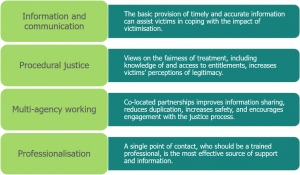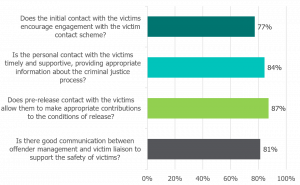Victim work
Key findings
- Accurate and timely information, providing a professional and fair service, and involving all key agencies have been found to be important for building victim confidence. Barriers to victim take-up of services include lack of awareness and fear of being blamed or re-traumatised.
- Restorative justice interventions are welcomed by victims and have been found to be associated with reductions in reoffending.
- There needs to be more specific evaluations of the value of victim awareness work.
Background
Victim contact work became a responsibility of the probation service through the first Victims’ Charter (1990). At that time the service was limited to contact with the families of homicide victims when the offender was approaching release from custody. Victim contact was extended further as part of the revised Victims’ Charter (1996) to include contact at the beginning of the sentence and to cover a wider range of victims; those where the offender was sentenced to at least 12 months in custody for sexual and/or violent offences. The Criminal Justice and Court Services Act (2000) placed victim contact work on a legislative footing for probation services.
The Government’s Victim Strategy (2018) included commitments for increased funding for services, easier opting-in to the Victim Contact Scheme, and improved training for Victim Liaison Officers.
Other key elements of probation victim work include restorative justice, facilitating mediation, and referring service users to victim awareness training.
Summary of the evidence
Services to victims
Victims often do not access services which may help them for several reasons:
- lack of knowledge about available services
- not wanting or believing they do not need victim services
- lack of access to services
- fear of re-victimisation, re-traumatisation, or blame by service providers
- lack of eligibility for services.
A 2016 evidence review by the Victim Commissioner found that most victims were dissatisfied by the services provided. The following themes were identified to improve services to victims:

Restorative justice
Restorative Justice (RJ) conferencing (face to face meetings between offenders and victims carefully managed by trained facilitators) has been found to be effective in reducing reoffending and increasing victim wellbeing and confidence in the justice system. RJ interventions can help to challenge rationalisations for crime, increase empathy for victims, and the supportive atmosphere can engender pro-social attitudes. Where wider community members are involved in RJ interventions, these volunteers may also provide practical assistance and social capital for the service user to help them towards a crime-free life.
Victim awareness work
Victim awareness work forms a central part of individual and group (cognitive-behavioural therapy) interventions, aimed at challenging and deconstructing victim-blaming and offence minimisation. However, there is no strong evidence that victim awareness in itself is effective in reducing reoffending, with evaluations assessing the broader interventions rather than this single component. It has been reported that denial is not predictive of violent or sexual reoffending and that there are more important targets for intervention.
We inspected the victim contact scheme at the request of the Victims’ Commissioner in 2013, in response to complaints received from victims. A small sample of victims (n=28) indicated general satisfaction with the scheme, but the scheme was not always clearly explained and thus some victims were not given enough information to decide whether to participate.
We examined the quality of contact provided to victims of John Worboys in 2018. We found that the National Probation Service had fulfilled its statutory duties. However, some of the letters were poorly drafted, lengthy and confusing, while the Information flows between probation officers and victim liaison officers were poor, hindered by changes of personnel.
Within our standards framework for our probation inspections, we have a specific standard for statutory victim work, considering whether relevant and timely information is provided to the victims of a serious offence, and whether they are given the opportunity to contribute their views at key points in the sentence. Findings from our 2018/2019 National Probation Service inspections are set out in the figure below. As shown, most victims were encouraged to engage through the initial contact (77 per cent of cases), and services were in the main tailored to the victim’s individual circumstances. There was consistent evidence of strong professional relationships, providing the foundation for effective information exchange (81 per cent of cases) and allowing victims to make appropriate contributions to licence conditions (87 per cent of cases).

Craissati, J. (2015). ‘Should we worry about sex offenders who deny their offences?’, Probation Journal, 62(4), pp. 395–405.
Sapouna, M., Bisset, C., Conlong, A. and Matthews, B. (2015). What Works to Reduce Reoffending: A Summary of the Evidence. Edinburgh: Justice Analytical Services, Scottish Government.
Strang, H., Sherman, L.W., Mayo-Wilson, E., Woods, D. and Ariel, B. (2013). Restorative Justice Conferencing Using Face-to-Face Meetings of Offenders and Victims: Effects on Offender Recidivism and Victim Satisfaction. A Systematic Review. Oslo: Campbell Systematic Reviews.
Wedlock, E. and Tapley, J. (2016). What works in supporting victims of crime: a rapid evidence assessment. London: Victim Commissioner.
Back to Specific types of delivery Next: MAPPA
Last updated: 17 May 2021



